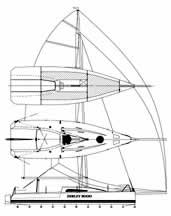Dibley 8000
Racerr
This is a very sexy hull shape. The entry is slightly hollow and the topsides flare out quickly to a maximum beam of 8 feet, 2 inches. There is almost some deadrise in the forefoot, but this quickly fairs away into a flattened section with slack bilges and a very narrow BWL. The beam at deck shows almost no taper as it goes aft from maximum beam. This will help keep the crew's weight well outboard. This is a very low-wetted-surface shape that will be a bit on the tippy side initially. Obviously the shape of this boat is intended to promote planing performance. The shape certainly does nothing to enhance form stability at moderate heel angles. The D/L is 77.
Draft with the keel down is 7 feet, 2 inches, and that's where the sail carrying power will come from. The keel fin is a hollow fabrication with two box-section stiffeners running full depth. The lead bulb is bolted to a flange plate at the bottom of the fin. The fin is deeply notched at the top end to allow the fin to be retracted for trailering. With the keel up the bulb is almost snug with the hull. The rudder is a very deep blade hung outboard and also retractable. There is a distinct hollow to the last 15 percent of the rudder foil. I prefer to choose rudder foils without any hollow to the section.
The deck is exactly what you would expect from a modern racing yacht. All the hard edges, including the sheer, have received generous radii. This should make hiking comfortable, almost. The house is a bubble shape, and the cockpit seat edge has been greatly softened for seating comfort. The plan form of the cockpit features a very wide well with minimal side decks. Every effort has been made to keep the crew's weight out of the stern for reduced pitching. The mainsheet traveler is on the cockpit sole.
There is no interior on this boat. Sure the drawings show four "berths," but there is no headroom and no room for a head. If that's a porta potty dotted in next to the keel trunk, you had better bring a big paper bag with you to put over your head, 'cause that's the only privacy you'll get on this boat. I wonder why you would even bother with a cabintrunk on a design like this.
This is a monster rig. The SA/D is 44. There is a retractable "prod" for asymmetrical, masthead spinnakers. A chute can be flown from the hounds in heavier weather. The mainsail has lots of roach, which is made possible by the lack of a standing backstay. The spreaders are swept and carry the cap shrouds to the masthead. With a rig this size you are going to really need that deep bulb plus all the crew weight on the rail to even begin to keep this boat on its feet. Maybe the "Cairns couple" consists of two, 250-pound, toothless ex-rugby players.
The rig numbers keep getting bigger, the hulls lighter, the keels deeper and the bulbs bigger. Make no mistake, this is not your mom's trailerable boat. A novice skipper and crew would probably find themselves in harm's way before they cleared the breakwater. Still we live in a world of "X-treme" sports and the quest for an ever-escalating adrenaline rush. For thrill factor I give this boat a 9.38. Nice work Mr. Dibley.

Comments